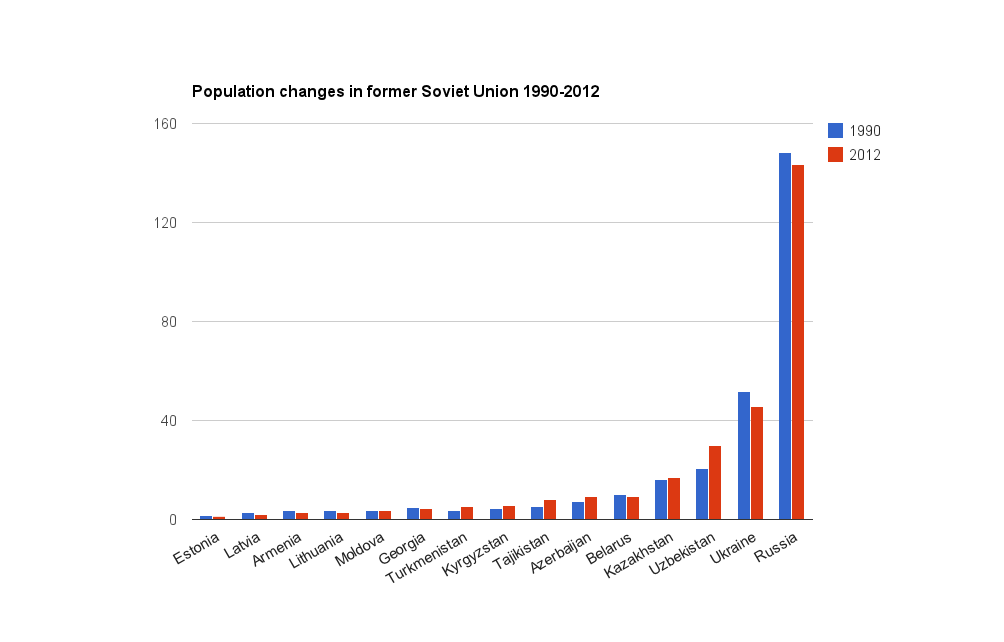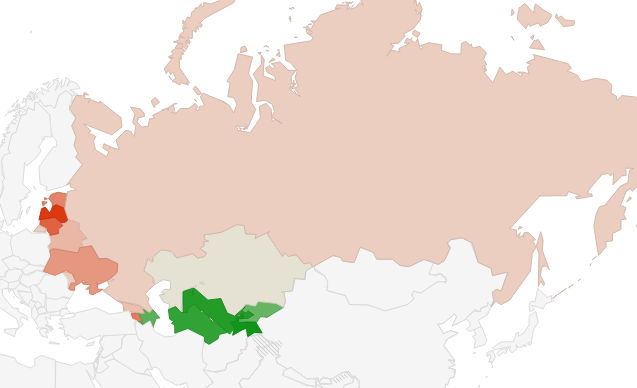15 former Soviet Union republics, then and now.
In 1990 in the Soviet Union lived 287.728 million people. In 2012 in the former republics lived 290.587 million people, which is 0.98% increase. A pretty small increase for 22 years.

The thing is, not all former Soviet republics have developed equally in next 22 years, since the collapse of Soviet Union.
Countries with population decrease:
| Country | 1990 | 2012 | Change mln | % |
| Latvia | 2.663 | 2.025 | -0.638 | -31.5 |
| Lithuania | 3.698 | 2.986 | -0.712 | -23.84 |
| Armenia | 3.545 | 2.969 | -0.576 | -19.4 |
| Estonia | 1.569 | 1.339 | -0.23 | -17.17 |
| Ukraine | 51.89 | 45.59 | -6.3 | -13.81 |
| Belarus | 10.19 | 9.464 | -0.72 | -7.67 |
| Georgia | 4.802 | 4.512 | -0.29 | -6.42 |
| Moldova | 3.696 | 3.56 | -0.136 | -3.82 |
| Russia | 148.3 | 143.5 | -4.8 | -3.34 |
Countries with population increase:
| Country | 1990 | 2012 | Change mln | % |
| Kazakhstan | 16.35 | 16.8 | 0.449 | 2.67 |
| Kyrgyzstan | 4.391 | 5.582 | 1.191 | 21.33 |
| Azerbaijan | 7.159 | 9.298 | 2.139 | 23.00 |
| Turkmenistan | 3.668 | 5.173 | 1.505 | 29.09 |
| Uzbekistan | 20.51 | 29.78 | 9.27 | 31.12 |
| Tajikistan | 5.297 | 8.009 | 2.712 | 33.86 |
Map of Former Soviet Union

The biggest population increase is in Central Asia, while the biggest decrease is in Baltic states. What is the future for Central Asian countries? Russia is emerging in the Eurasian Union, and Kazakhstan is one of the founding members. Does Russia see the huge potential in developing countries like Uzbekistan?
What about Baltics? The GDP per capita in Baltic's is much higher than in Central Asia (except Kazakhstan), but people leave their countries? Why? Is it free European Union job market? Are there any options for Baltics to attract immigrants? From where? From Central Asia? Are the Baltic's ready for such offer? What can Baltic states offer to Central Asian immigrants? Language barrier? Why should some job seeker from Uzbekistan seek a job in Estonia or Latvia, while he can work in Russia, Kazakhstan where the life level is the same as in Baltics? Huh?
Some must think of this a lot in close future!
